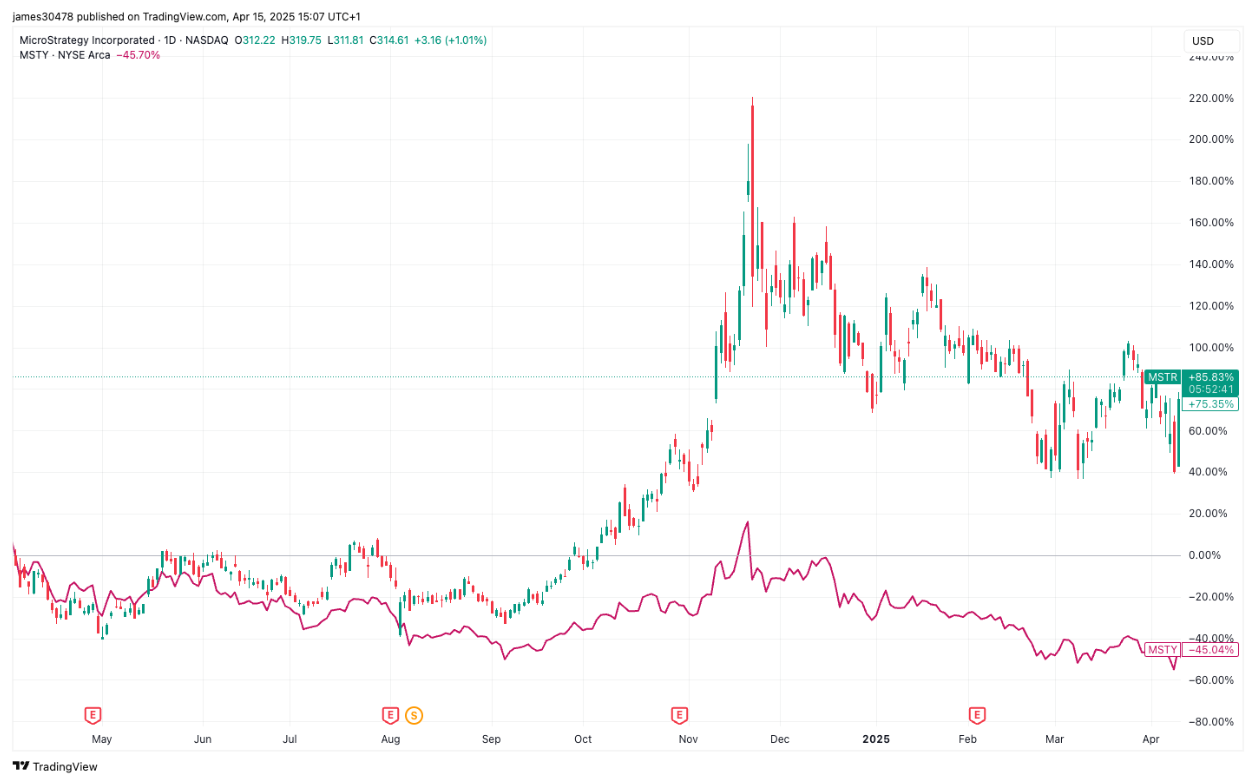Uncategorized
MSTR vs. MSTY: Growth or Income? A 12-Month Showdown

Disclaimer: The analyst who wrote this piece owns shares of Strategy (MSTR).
From April 2024 to April 2025, investors in Strategy (MSTR) and the YieldMax MSTR Option Income Strategy ETF (MSTY) followed two distinctly different investment paths — one seeking capital appreciation through bitcoin (BTC) exposure, the other pursuing monthly income via options-based strategies. Both are linked to the performance of MSTR, but their outcomes and structures diverged significantly.
Strategy, listed on the Nasdaq, has evolved from an enterprise software company into a de facto bitcoin proxy. As of April 15, the company holds 531,644 BTC, making its stock highly sensitive to bitcoin’s price movements. Since adopting its bitcoin treasury strategy in August 2020, MSTR shares have surged over 2,500%. However, this growth comes with volatility: Currently, the stock has an implied volatility of 87%, and a 30-day historic volatility of 102%. MSTR is currently 43% below its all-time high set in November 2024, reflecting the sharp swings typical of a bitcoin-correlated asset. The stock pays no dividend.
In contrast, MSTY, launched in April 2024, is an income-focused ETF that does not hold MSTR shares directly. MSTY’s portfolio consists primarily of U.S. Treasury bills, cash, and short-term call options on MSTR, allowing it to synthetically replicate exposure without directly owning the stock.
It employs a synthetic covered call strategy, selling options on MSTR to generate monthly income. This strategy limits upside participation but delivers consistent cash flow, appealing to investors seeking regular distributions.
From April 4, 2024 to April 9, 2025, a $1,000 investment in each product produced the following results:
MSTR: Fueled by bitcoin’s strong 2024 rally, the investment grew to $1,895, generating a +86% total return.
MSTY: With 13 monthly distributions totaling $36.53 (ranging from $4.13 in April 2024 to $1.33 in April 2025) reinvested on each ex-dividend date, the investment reached $1,591, a +59% total return.
However, MSTY declined 45% over the year due to its full downside exposure to MSTR’s price movements, without benefiting fully from MSTR’s rallies because of its call-writing strategy. Additionally, consistent high monthly distributions — partly classified as return of capital — reduced the fund’s net asset value over time, further weighing on its share price.
MSTY exhibited significant volatility in its own right, often trading at premiums or discounts to net asset value (NAV), introducing additional price risk.
The premium/discount activity in MSTY reflects both investor demand and underlying volatility in MSTR. Early high volatility supported strong option income and trading premiums, but as volatility eased in 2025, premiums narrowed and discounts appeared more often. However, a renewed bitcoin rally and rising volatility in MSTR could reverse this trend, lifting option income, distributions, and investor demand.

While both products are linked to MSTR’s price action, they serve distinct purposes: MSTR offers high-risk growth potential tied to bitcoin, while MSTY delivers yield through a derivatives-based income strategy with inherent structural limitations.
Unlike traditional income strategies that focus on low-volatility, stable-yield investments like broad index ETFs or dividend stocks. MSTY is geared toward retail investors seeking exceptionally high income — but who are also willing to accept significantly higher risk and volatility.
Uncategorized
Canary Capital Files for Tron ETF With Staking Capabilities

Canary Capital is looking to launch an exchange-traded fund (ETF) tracking the price of Tron’s native token, TRX, according to a filing.
The hedge fund submitted a Form S-1 for the Canary Staked TRX ETF with the Securities and Exchange Commission (SEC) on Friday. As the name suggests, the fund — if approved — would stake portions of its holdings.
This would be done through third-party providers, with BitGo acting as custodian for the assets. The fund would track TRX’s spot price using CoinDesk Indices calculations.
A proposed ticker as well as the management fee for the product have not been shared yet.
Issuers had initially filed applications for spot ethereum (ETH) ETFs with the staking feature included but removed them in an amended filing later in order to receive approval from the SEC on their proposals.
While the SEC under former Chair Gary Gensler was strictly against staking, issuers have grown more hopeful that they will be able to add the feature to their spot ether funds, among others, with the appointment of crypto-friendly Chair Paul Atkins.
A decision on a February request from Grayscale to allow staking in the Grayscale Ethereum Trust ETF (ETHE) and the Grayscale Ethereum Mini Trust ETF (ETH) was postponed by the regulator just a few days ago.
Uncategorized
Feds Mistakenly Order Estonian HashFlare Fraudsters to Self-Deport Ahead of Sentencing

Just four months ahead of their criminal sentencing for operating a $577 million cryptocurrency mining Ponzi scheme, the two Estonian founders of HashFlare were seemingly mistakenly ordered to self-deport by the U.S. Department of Homeland Security (DHS) — an instruction that directly contradicted a court order for the men to remain in Washington state until they are sentenced in August.
In a joint letter to the court last week, lawyers for Sergei Potapenko and Ivan Turogin told District Judge Robert Lasnik of the Western District of Washington that both men had received “disturbing communications” from DHS ordering them to leave the country immediately.
“It is time for you to leave the United States,” an email to Potapenko and Turogin dated April 11 read. “DHS is terminating your parole. Do not attempt to remain in the United States — the federal government will find you. Please depart the United States immediately.”
The email, included with the letter filed last week, threatened both men with “criminal prosecution, civil fines, and penalties and any other lawful options available to the federal government” if they stayed in the country. It resembles emails that undocumented immigrants and U.S. citizens alike have received over the past few days.
Ironically, Potapenko and Turogin are not in the U.S. of their own volition — they were extradited from their native Estonia at the request of the U.S. Department of Justice in 2022 on an 18-count indictment tied to their HashFlare scheme. Though they initially pleaded not guilty to all charges, in February they both pleaded guilty to one count of conspiracy to commit wire fraud, which carries a maximum sentence of 20 years in prison, and agreed to forfeit over $400 million in assets. They have both been in the Seattle area on bond since last July.
“Although there is nothing Ivan and Sergei would want more than to immediately go home, they understood that they are also under Court order to remain in King County,” wrote Mark Bini, a partner at Reed Smith LLP and lead counsel for Potenko, wrote in the pair’s joint letter to the court. Bini did not respond to CoinDesk’s request for comment.
In his letter, Bini said DHS’s emails had caused both Potapenko and Turogin «significant anxiety.”
“We and our clients have all seen recent news. Immigration authorities make mistakes, and individuals who should not be in custody end up in custody, sometimes even deported to places where they should not be deported,” Bini wrote.
Six days after Bini’s letter to the judge, the DOJ filed its own letter with the court saying that prosecutors had coordinated with DHS’s Homeland Security Investigations (HSI) division and secured a year-long deferral to the self-deportation order.
“This should provide ample time for the sentencing to take place,” the prosecution’s letter said.
DHS did not respond to CoinDesk’s request for comment.
Potapenko and Turogin are slated to be sentenced on August 14 in Seattle. Their lawyers have said that they will request to be sentenced to time served, meaning no additional time in prison, and to be sent home to Estonia “immediately.”
Uncategorized
CoinDesk Weekly Recap: EigenLayer, Kraken, Coinbase, AWS

Following last week’s tariff-caused drama, this was a relatively quiet week in crypto. Bitcoin remained stable around $84k. The CoinDesk 20, which tracks about 80% of the market, was up about 4% in the last seven days — i.e. nothing historic.
Still, plenty happened. On Tuesday, much of crypto went offline because of a tech issue at AWS, showing how the decentralized economy isn’t always that decentralized. Shaurya Malwa reported the news early. Bitcoin and other major cryptos slipped on bad news for Nvidia, Omkar Godbole reported.
Mantra, a project focused on real world assets, lost 90% of its value. Explanations varied (the company said it was due to “force liquidations” exchanges).
Meanwhile, EigenLayer, a restaking leader, rolled out a “slashing” feature meant to address security concerns (Sam Kessler reported). OKX, a major exchange, announced plans to set up in California following a $500 million settlement with the SEC over claims it operated previously in the U.S. without a money transmitter license. Cheyenne Ligon had that story.
In less good news, Kraken laid off “hundreds” of staff ahead of an expected IPO. And Coinbase became embroiled in a “front running controversy” linked to a curiously named token on its Base L2. Privacy advocates reacted with alarm to rumors that Binance was about to delist Zcash following a long decline in the value of privacy coins.
In D.C. news, Jesse Hamilton reported on a new wave of crypto lobbyists flooding the capital. Some asked if there are now too many trade groups and whether they really all could be effective.
Friends With Benefits, a buzzy social club for creative technologists, launched a new program to build Web3 products for music, film, publishing and other fun activities. (I wrote that one.)
Of course, there was plenty happening in the economy and markets (Trump’s disgust for Fed chair Powell fed into the unease). But, in crypto, it was pretty much business as usual. Fortunes won, fortunes lost, fortunes deferred.
-

 Fashion6 месяцев ago
Fashion6 месяцев agoThese \’90s fashion trends are making a comeback in 2017
-

 Entertainment6 месяцев ago
Entertainment6 месяцев agoThe final 6 \’Game of Thrones\’ episodes might feel like a full season
-

 Fashion6 месяцев ago
Fashion6 месяцев agoAccording to Dior Couture, this taboo fashion accessory is back
-

 Entertainment6 месяцев ago
Entertainment6 месяцев agoThe old and New Edition cast comes together to perform
-

 Sports6 месяцев ago
Sports6 месяцев agoPhillies\’ Aaron Altherr makes mind-boggling barehanded play
-

 Business6 месяцев ago
Business6 месяцев agoUber and Lyft are finally available in all of New York State
-

 Entertainment6 месяцев ago
Entertainment6 месяцев agoDisney\’s live-action Aladdin finally finds its stars
-

 Sports6 месяцев ago
Sports6 месяцев agoSteph Curry finally got the contract he deserves from the Warriors





